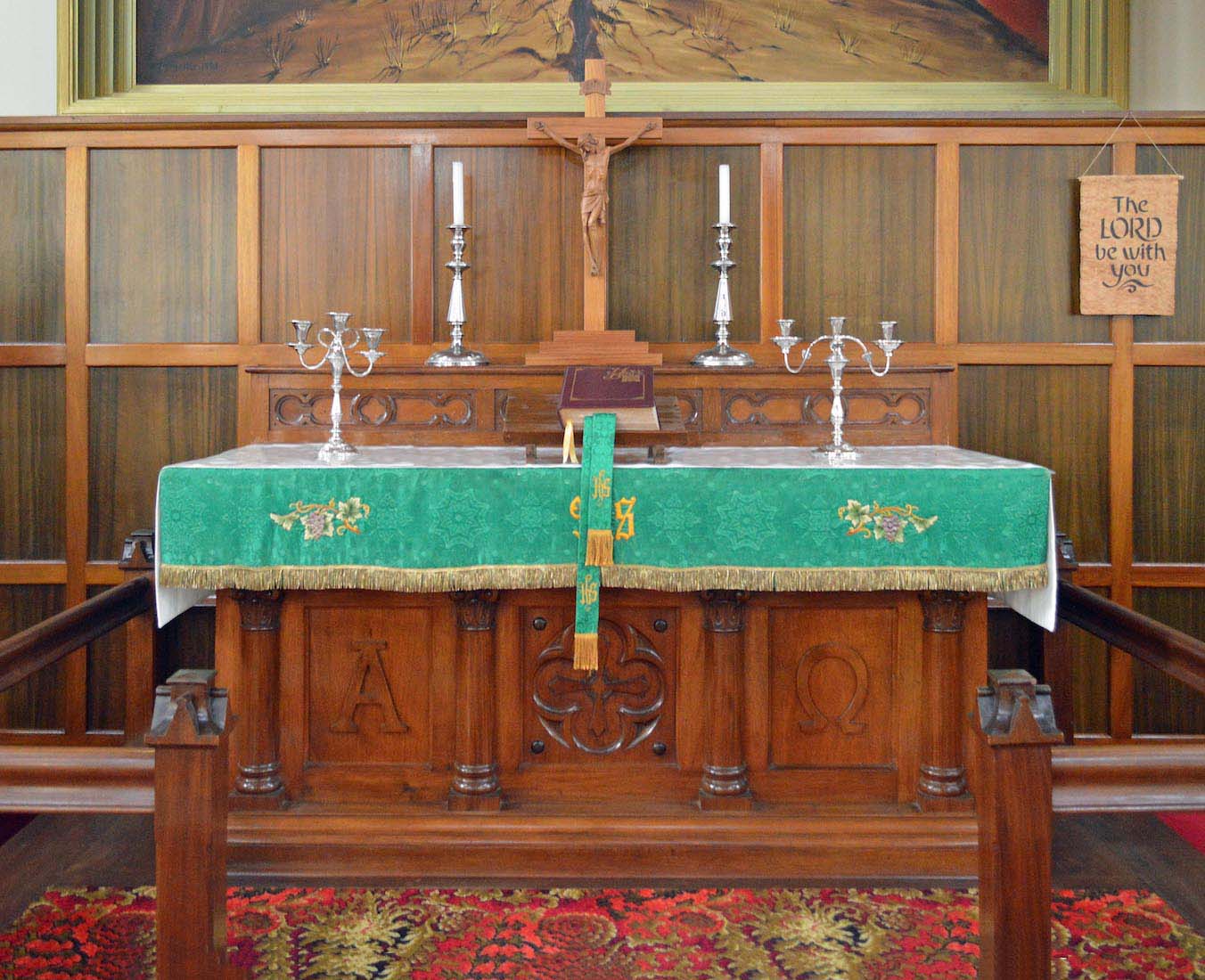22. PHOTO GALLERY

The Pastors of St John’s shown here have dates from 1852 to 2016. There is need for a new photo board!
23. ANGEL
We take a moment to venture into the Church porch where we find this angelic figure – but unfortunately with no details.
24. BANNER AND PHOTOGRAPH
The colourful banner at left obviously celebrates some Church mission connection with the Aborigines. The photograph at right depicts a group of ministers attending a Conference of the United Evangelical Lutheran Church of Australia which was held at Ebenezer in 1921.
25. ORGAN
The organ in St John’s, was built by D.H. Lemke in 1875. This date, together with Lemke’s signature is written on one of the wooden pipes inside the organ. This organ can still be foot-pumped. The amount of air in the bellows is indicated by two tassels situated on either side of the keyboard. While playing the organ the performer needs to give constant attention to the position of these tassels – it is very easy for the wind to ‘run out’ quite suddenly and unexpectedly. The superb tonal qualities of this organ remain undiminished and undisturbed by the passage of time. A slight unsteadiness of wind-supply adds a ‘breath of life’ to this organ. (From Historic Organs of the Barossa Valley, Volume 2.) Statistics for those ‘in the know’: B 1875 D.H. Lemke. 1 manual, 4 speaking stops, no pedals, foot blown. Man: 8.8.4.2.
26. SANCTUARY
We descend from the balcony, and make our way down to the sanctuary. Notice that the two windows in the far East wall are of clear glass.
27. FONT AND LECTERN
There is a small plaque at the base of the Cross on the lectern at right. It reads: ‘To commemorate the 100 years of continuous children’s ministry at Ebenezer since 1901’. The font and silver jug are characteristic of these Barossa Valley churches. Around the lip of the font is written in German the words of Jesus: ‘Suffer the little children to come unto me.’
28. PULPIT AND CANDLE
The pulpit is from where the Gospel is preached week by week. The Paschal candle represents the Light of Christ coming into the world. It is lit over the Easter period, and also on special occasions through the year.
29. TRINITY BANNERS
The little banner over the pulpit, and the banner behind on the East wall can be described as Trinity banners. They represent the Godhead of Father, Son and Holy Spirit. The three interlinking circles is an attempt to represent God as ‘three persons in one substance’.
30. CRUCIFIXION MURAL
In 1955 Pastor A. Simpfendorfer commissioned German artist George Selke to paint the large crucifixion mural which stands above the altar. Unusually it shows Mary the mother of Jesus and the disciple John standing on the same side of the Cross. Under the mural and to the right is the text: ‘The Lord be with you’.
31. ALTAR
On the base of the altar are the letters ‘Alpha’ and ‘Omega’ – the first and last letters of the Greek alphabet used in the Book of Revelation to describe Christ as ‘The Beginning and the End’. The altar with its crucifix and open Bible is the real focus of worship in the Church. It is from here that the Eucharist is administered.
32. CRUCIFIX AND BIBLE
Crucifix and Bible: two common features of all the Barossa Valley Lutheran churches. The Bible is the Word of God which tells of his salvation plan. The crucifix shows Christ crucified on the Cross for our redemption.

CONCLUSION
I hope you have enjoyed visiting Ebenezer – St John’s Lutheran Church with me. Although there are similarities shared by the Barossa Valley churches, there are also significant differences, and St John’s is no exception.
My thanks to Pastor Mathew Ker who very kindly took the time to open his three! churches for us, and accompanied us on his motor cycle.
I am very happy to receive any corrections or constructive comments about this site: the best websites are those which have no errors! I am grateful to my wife Margie who came with me and who has done much valuable proof reading.
St John’s has a website address with link:
http://ebenezer.lutheran.org.au
The photos on this site are all mine, and can also be found in higher resolution at:
https://www.flickr.com/photos/paulscottinfo/albums/
Site created: 08 / 2020
Paul Scott











